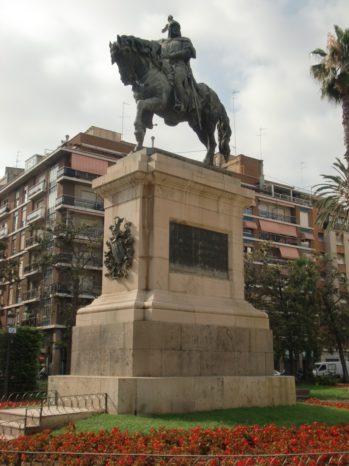James I
The statue of 1,500 kilograms, was placed on a pedestal that had been raised some years ago, In the front was placed the quadribarrada with the winged dragon as used by the Aragonese monarchs, and in the back, the coat of arms of the city of Valencia.
The work was placed on January 12, 1891 with an anterior pedestal and weight of 11,500 kgrs. Sixteen years had to pass from the moment the idea of erecting the monument to its complete completion.
Later, the coat of arms of King Jaime was placed on the pedestal in its front part and on the back the coat of arms of the city of Valencia, modeled by the sculptor José Aixá Iñigo. On the sides were placed two bronze plaques with the inscription: To King James the Conqueror, founder of the Valencian kingdom, grateful Valencia. Year M.D.CCC.XCI. He entered Valencia victorious, freeing it from the Muslim yoke, on the day of San Dionisio IX October of M.CC.XXXVI.
The sculpture depicts King James I in warrior’s costume mounted on his horse as he passes and in the attitude of leading the troops in their conquest towards the city of Valencia. It is much larger than natural. The helmet of the conquering king stands out, which is a historical anachronism since this type of summit was not used until the times of King Peter IV the Ceremonious.
We can admire presiding over the Parterre, the equestrian sculpture of King James I the Conqueror on horseback. The idea arose in 1875 around the director of the newspaper Las Provincias, Don Teodoro Llorente Olivares and approved by the City Council in 1876 with the condition that it should be made by public subscription.
In 1878 the necessary money for the project had not yet been collected, so it was decided to raise the pedestal on which the statue would rise and which would be made by the municipal architect Vicente Constantino March with a height of seven and a half meters.
The commission and manufacture of this work gave much to talk about in the local press of his time, since no Valencian sculptor was hired, but the commission in charge in 1882 turned to Agapito and Venancio Vallmitjana Barbany of Barcelona, for the realization of the work, two of the best Spanish sculptors of the moment.
In return, it was determined that the casting of the sculpture would be carried out in Valencian workshops, specifically in La Maquinista Valenciana, a company that offered the most reasonable budget: 30,000 pestas. The foundry was directed by Francisco Climent.
The sculpture was carved in wood by Agapito Vallmitjana and approved by the commission commissioned in 1886. Fifteen tons of bronze were requested from the Ministry of War, which were granted by sending five cannons and a howitzer that were brought from Peñiscola Castle.

Dades bàsiques
Plaza de Alfonso el Magnánimo, s/n
46003 Valencia